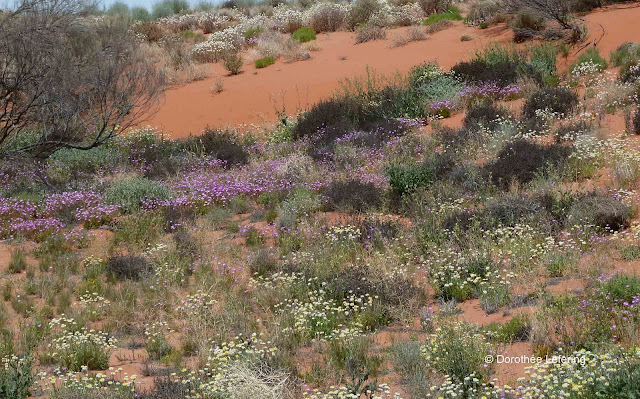I want to lay you down in a bed of roses … you know that
song. I have yet to sleep in a bed of roses in the outback, but I saw hundreds
of other flowers, flowering bushes and trees.
Wildflowers in the outback of the centre of Australia
The wildflowers in the outback of the centre of Australia, in Queensland, New South Wales, Victoria, South Australia and the Northern Territory are in bloom from September. If it rains a lot during winter (that is June, July and August in Australia) the Red Centre can be easily called the green centre. And that are the moments when the chests of locals of the region swell with pride. There is usually hardly any rain in the outback. They well know that many visitors will never experience the area like this. They say that the sea of flowers is the most special sight.
You know, the Ozis tend to sometimes carry their
description of places (slightly) too far, certainly they just want to be kind (and surely excel).
I decided I had to see for myself whether the Outback turns green in spring.
There are so many different kinds of flowers out there in
the backcountry of Australia. I really don’t want to disappoint you, but this
is not a botanist-Info platform, so I just name a few of the flowers to set you
in the mood. Tiny Purslane, Broad-Leaf Parakeelya, Goodenia vilmoriniae, Yellow
Top, Tall Mulla Mulla, Large Green Pussytail, Sturt's Desert Pea, Schenkia
australis, Minnie Daisy, White Paper Daisy, Woolly-Headed Burr Daisy, Poached
Egg Daisy, Bush Tomato, Australian Bluebell, Yellow-keeled Swainsona, Rosy
Dock, Sturt's Desert Rose, Desert Grevillea, Scholtzia uberiflora. The
interested reader might browse a plant encyclopedia or contact the Australian Native Plant Society now.
Poached Egg Daisy
But hang on. Let me at
least introduce a really super cute one I found. I saw one wildflower that
looks exactly like a fried egg. Strictly speaking, it is reminiscent of an
oversized daisy and a fried egg. I later found out, that it is colloquially
probably called Poached Egg Daisy because of that. The plant from the family of daisies
grows in sandy ground and measures
about 4 cm
on average and is 15 to 50 cm high.
The actual name of the plant is Polycalymma stuartii,
and was named after the Scottish explorer and surveyor John McDouall Stuart.
It is enchanting indeed, to see all the colourful blooming flowers and tall grasses in the red sandy ground. Flowers that cover the plains like a carpet and grow up all the way to the mountain ranges in the distance. Heavenly.
Heat. Drought. Dust. And yet, the flowers, shrubs, trees
blossom and grow all over the place. They make it seem to be the easiest thing in the
world, to survive under these conditions.
The flowers are standing on the red dunes and their
cheerful and lively spirit create an even better mood, than the one you are
customarily in when on a road trip through the Red Centre. If you can do it
somehow, go and make your way up there … now. Read: How to drive from
Melbourne in the State of Victoria to Uluru in Northern Territory.
From Berlin with love

